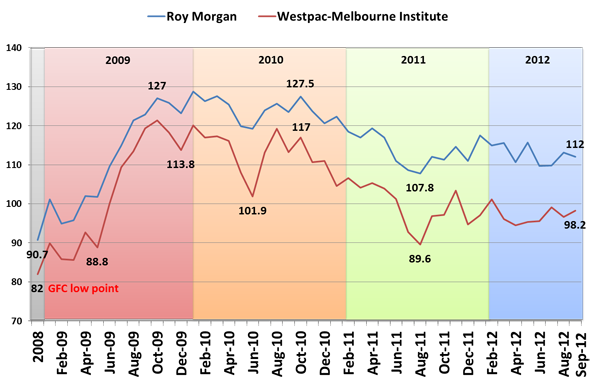Consumers stuck in a rut as bad as during the GFC
Share
Consumers are well and truly stuck in a rut, according to the latest consumer confidence figures, which show September’s confidence levels to be as bad if not worse than during the height of the global financial crisis.
Westpac-Melbourne Institute (WMI) said consumers are in an “extended cautiously pessimistic phase” with September the seventh consecutive month that the Index has been below 100, a stretch only surpassed in 2008/09 and the early 1990s.
Roy Morgan Research reports that September’s consumer confidence reading is one of the lowest since the GFC. However, it remains a much higher reading at 112.0 points compared to WMI’s at 98.2.
Both confidence indices are calculated from a neutral point of 100 plus or minus the average number of favourable or unfavourable answers to five key questions. A score above 100 indicates that the number of optimists outweigh the number of pessimists and vice-versa for a number below 100. Fieldwork for Roy Morgan’s study was conducted on the weekend of September 8/9 while WMI’s took place between 3 and 8 September.
Chief economist at Westpac, Bill Evans says the results does not bode well for consumer spending and is consistent with the slowdown in consumer spending indicated by the June quarter national accounts. “With a sharp fall in July retail sales confirming this boost is now reversing, underlying momentum appears to be soft, in line with the consistently downbeat signal from the consumer sentiment index.”
Executive Chairman of Roy Morgan Research, Gary Morgan, pointed to a weakening in the mining sector for these latest consumer confidence figures. “The weakness in iron ore prices and another key commodity – coal – suggest Australia’s mining boom may be coming to an end, threatening the Gillard Government’s promised surplus.
“Notably, iron ore miner Fortescue last week responded to the falling iron ore price by cancelling a planned expansion in WA’s Pilbara, sacking 1,000 employees and contractors. Extensive publicity has also surrounded BHP Billiton’s cancellation of a proposed $30 billion expansion of its Olympic Dam copper and uranium mine in South Australia and the shelving of plans to expand its port facilities in Port Hedland – further clear indications of the weakness of commodity prices.”
WMI’s index rose slightly over the past month, up 1.6 points to 98.2, while Roy Morgan’s dropped by 3.4 points to 112.0. Both are reading at or below the levels of September last year.














